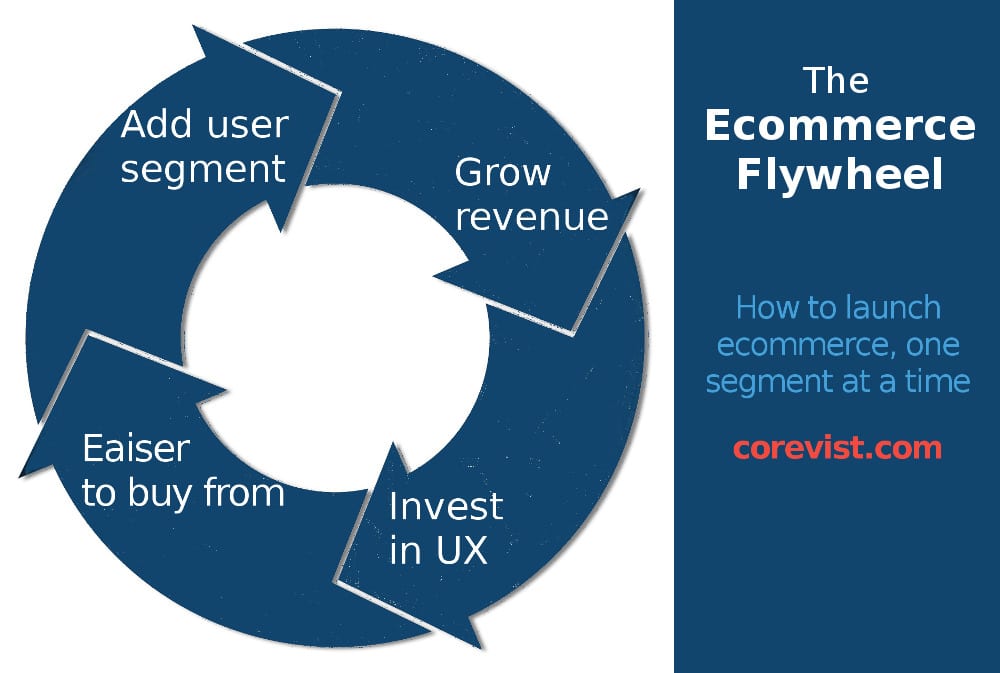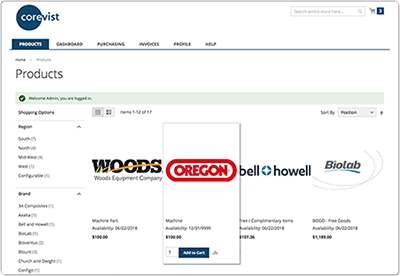Share
Author
George Anderson
Share
Got a bad case of content anxiety?
Content anxiety is a real problem in B2B ecommerce. If you’re planning your organization’s first foray into ecommerce, you may not have your product content ready to go. When you go looking for an ecommerce solution, you encounter vendors who want to start with that product content before all else. How can you launch ecommerce and start taking web orders if that product content isn’t ready?
We have good news: you don’t need to have all your ducks in a row as far as catalog content. In fact, you can launch ecommerce following a carefully-crafted rollout plan that uses the data you do have on hand in SAP to extend self-service ordering to a subset of your customers.
When you do, you’ll create a positive feedback loop of increased revenue which you can use to invest in better UX for customers who need it. We call this feedback loop the Ecommerce Flywheel.
We’ll look at the Ecommerce Flywheel in a minute. But first, here are 4 steps you can take to alleviate content anxiety, launch web ordering now, and get your Ecommerce Flywheel turning.
1. Segment your customers
In B2B, not all customers are created equal—and that’s where you can start your ecommerce rollout plan. Think of it like this: product content exists to educate buyers who don’t know what they’re looking at. It facilitates browsing, comparison, and decision making.
Do all your customers engage in that kind of process?
Chances are, you have a subset of customers who don’t need to make any decisions before ordering from you. They order by SKU—maybe even a fixed quantity of product at fixed intervals.
These users don’t need product content. In fact, they might tell you it just gets in their way. But they’re ordering from you today by calling, emailing, or faxing your Customer Service department.
Break your customers into two segments based on this distinction:
- Power users—people who don’t need rich content because they already place orders by SKU. These are the users you’ll cater to in the first iteration of your project—a simple B2B ordering portal that’s integrated to SAP in real time.
- Less-committed users—people who do need rich content to help them understand your offerings, close the sale, and increase the value of your interaction with them.
Looking for B2B ecommerce?
Corevist Commerce offers ecommerce + customer dashboard,
integrated to SAP.
2. Launch an ordering portal for your power users
Ordering portal? That doesn’t sound like ecommerce. Ecommerce means an Amazon-style experience, right?
In B2C, yes. But in B2B, ecommerce comes in all kinds of flavors. For many manufacturers, a simple Corevist Commerce ordering portal integrated to SAP is enough. Because it offers 24x7x365 self-service ordering, it makes you easier to do business with for power users—they already order by SKU, so they’re prepared to key in that SKU number in the ordering portal.
Not only is a Corevist portal easy for your customers to use, but it simplifies your order fulfillment process by eliminating errors. Because a Corevist Commerce portal simulates orders against SAP, the portal also returns error messages and only allows 100% SAP-accurate orders to post.
When you launch a simple B2B ordering portal for your power users, you make huge strides in efficiency today by freeing up your CSRs from mundane tasks. (Hint: you can calculate your ROI with our web-based calculator.) As you reduce the overhead cost of order processing and become easier to do business with, you become more profitable. You can use that profit to fund the next iteration of your rollout plan—catalog-based ecommerce.
3. Launch a catalog for your less-committed users
If you’re like most B2B manufacturers, you don’t sell only to your power users. You may also have less-committed users in other segments. Because they’re less specialized, users in these segments need rich content to understand your product offering and to entice them to buy.
What do less-committed users look like? Here are some examples:
- Smaller distributors who don’t use EDI
- Dealers
- B2C consumers
What kind of help do these users need? Why is a bare-bones, SKU-driven portal not enough? At a high level, it’s pretty simple. They need help finding the right product. Depending on your market, that can mean several types of functionality.
- Easy download of product user manual
- Interactive parts diagrams for visual reordering
- Standard B2C-style product catalog with advanced search
- Personalized catalogs based on related products and/or order history
Your less-sophisticated users may not need all of these technologies, but chances are, they need at least one of them.
When you launch a catalog to meet the needs of these segments, you become easier to do business with and offer a solution that works for all users regardless of their level of sophistication. That leads to greater cost-savings and revenue. It’s a positive feedback loop, one we call the Ecommerce Flywheel.
4. Get your Ecommerce Flywheel turning
The Ecommerce Flywheel gets turning once you have revenue flowing in from the first stage of your ecommerce rollout plan. After that, the cycle continues to run as you grow revenue, invest in UX improvements, become easier to do business with, and add another market segment.
Here’s what it looks like.

The Takeaway
Got a bad case of content anxiety? Don’t let it stop you from taking the first step. Perfection is the enemy of the good. Get value as quickly as you can, and you’ll start your Ecommerce Flywheel, even if it turns slowly at first.
Here’s a quick recap of how to do that:
- Segment your users
- Organize your projects to deliver the most value with the least investment on your part
- When you start generating value both to you clients and within your organization, you’ll generate your organization’s Ecommerce Flywheel. That allows you to invest more over time for people who need more help buying from you.
Moving forward: FREE case study
Curious what the Ecommerce Flywheel looks like at a real company? Download this FREE case study on Mannington Mills. You’ll learn how Mannington launched an ordering portal integrated to SAP in real time, then upgraded to full B2C-style UX when they were ready. The best part? Sales increased 150% after the catalog launch.
Download your FREE case study
[want_more title=”Learn more” subtitle=”FREE Case study: 150% Sales Growth with Rich Content” description=”Learn how a leading flooring manufacturer doubled sales with a B2C-style catalog.” button_text=”Download Now” button_link=”/” button_class=”btn btn-primary mannington-ae” title2=”See it for yourself” subtitle2=”Talk to us” description2=”Curious what Corevist Commerce can do for you? Let us show you a personalized demo. You’ll see ecommerce with real-time SAP data.” button_text2=”Schedule Demo” button_link2=”https://www.corevist.com/demo/” button_class2=”demo-popup”]










